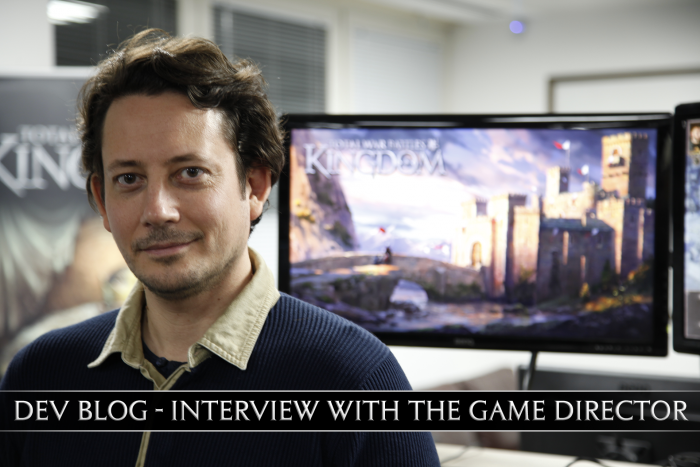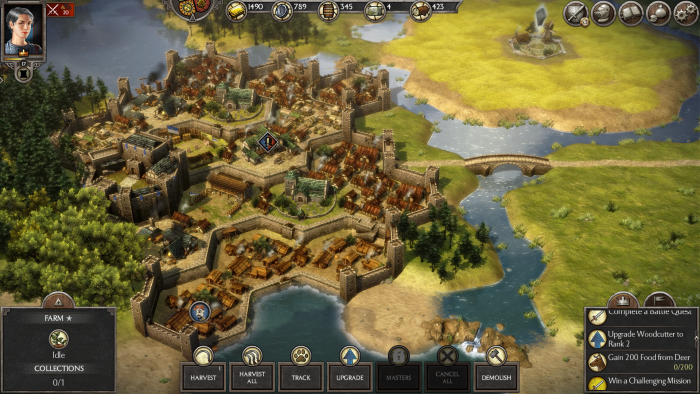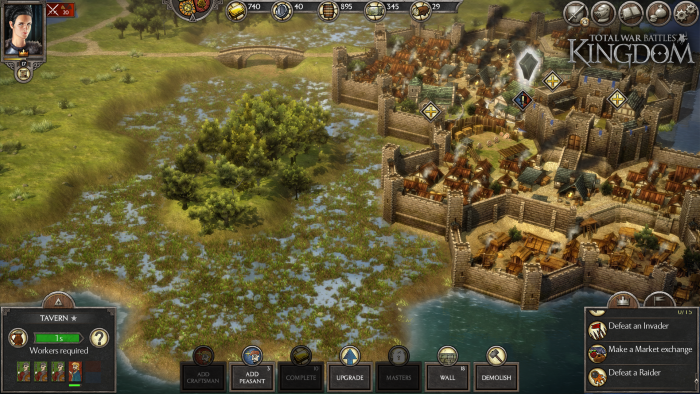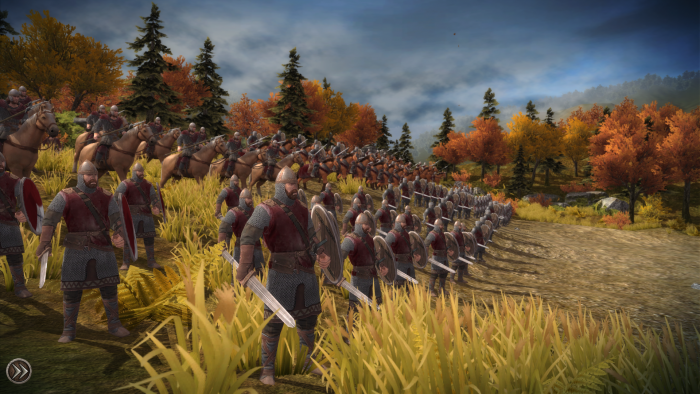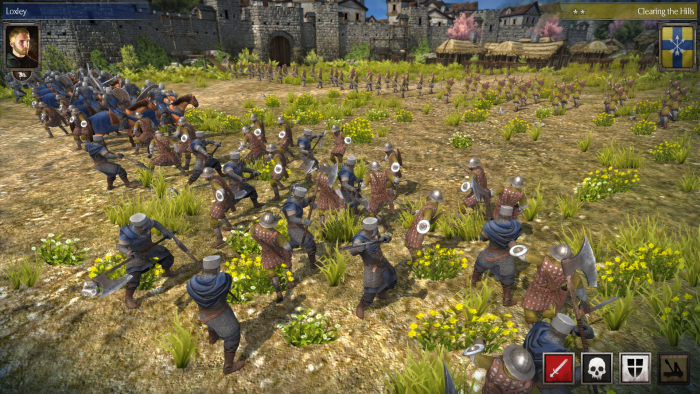Developers Blog 2
Interview with the Game Director
This week we sat down with our Game Director for a chat about KINGDOM, where it came from and what makes it special.
Could you tell us a little bit more about you and your role in the team?
I’m Renaud Charpentier, the Game Director for Total War Battles: KINGDOM. This means that I lead the team crafting the game and I design the high level content of the game.
Since we are a small team and only have one other designer, I also did a lot of the system design, balancing etc.
How did the idea for Kingdom come up?
Kingdom is the second project of our team – first we made Total War Battles: Shogun, which was pretty well received.
Shogun was still in a classic RTS format with both your economy and your battle on the same map and it was also meant to run on iPhone 3GS, so devices which now feel fairly old and slow. So we started at looking at what we could do next.
I had this vision of these devices – smart phones, tablets and so on – becoming extremely powerful in the years to come and that it would take us years to craft this game, so I thought we should be ambitious and do something that really hasn’t been done before and would be reaching further than the first game.
So we went back to look at Total War to figure out if we could get closer to the spirit and DNA of the PC franchise.
Two things that we really wanted were on one hand an economy that is much closer to what you do in a Total War campaign, where you conquer territory, manage it, optimise it and so on. That means to have something that persists and you build over time instead of just having it on the map you’re playing right now, like it is in a classic RTS. Secondly, we wanted to capture the large, epic scale battles Total War is known for.
So these were the main design directions we had when we started out.
Because this was going to be very challenging on mobile, we started prototyping and tried to see how far we could go with that.
In addition, we wanted to create a game in which you’re not playing isolated, because these devices are already always connected, whether that is via WiFi or mobile broadband, and we wanted to make use of that. So we aimed for a game in which you join a server with an existing world, in our case England in the 10th century, which is inhabited by other players as well, who you can play with or against, who can be your friends and so on – in essence a MMO-type experience.
This lead to quite a lot of technical challenges, because it’s much more complicated to make a server based game than a stand-alone game like the one we did before.
What were the greatest challenges you had to overcome?
To be honest there were so many challenges, it’s hard to pick one.
Almost every aspect of the game was really challenging to do, for example the Realm.
We wanted to do something really new here and went for a sandbox simulation. You could say that was heavily influenced by ideas which came from games like Minecraft where you have a lot of freedom in what you do, including terraforming the land, growing trees, etc.
Basically you don’t interact with a fixed area mini base; instead you interact with a full simulation of a Kingdom. That means time passes, the seasons change, wheat will grow, water flows downwards, animals appear, you can hunt them and so on. We wanted to simulate an entire micro eco-system and that proved to be very challenging.
Additionally this had to happen on a live server, making it even more challenging. It had to be well optimised, since many players would play at the same time and the server would have to be able to calculate all of that.
Therefore making the client for the game was a great challenge, having it run on a server was challenging and the battles posed a tough job as well, because we wanted to make sure that whatever devices you’re playing on – be it a smart phone, tablet, PC, etc. – you could play against another player online, no matter what kind of device you or they were playing on.
There are very few games doing this and to our knowledge even fewer which do it in real-time. A game like Hearthstone does it, you can play it on a tablet or phone vs. someone on a PC and you wouldn’t notice. But even this is sort of a turn-by-turn game whereas our battles are 3 minutes of real-time action.
We also tried to push the rendering to the max, so that our battles are more representative of what battles would have been like in 10th century England. At that time a ‘huge army’ would comprise of a couple of thousands of men, instead of tens of thousands. Our battles can go up to 400 3D animated men on screen, which is a very rare sight on mobile devices. Making sure the rendering would work and run smoothly was a tough nut to crack.
Because the game features MMO-type elements, we have to support the game much more than you would have to in a single player game. For example if you play a level in a single player game and it crashes you can simply restart it.
Whereas if a realm or battle crashes in KINGDOM it has long term implications, because you keep the same realm for months. So we need to make sure the quality assurance (QA) and the server system were to the best standard possible, in order to detect all of the errors and fix them. It does in fact force you to raise the quality bar even higher and QA it to the very last bit.
What makes Total War Battles: KINGDOM stand out for you?
I think on the realm part of the game it’s really the fact that it’s a simulation, a “Living Kingdom” if you like.
You’re free to do what you want.
You can really reshape your land and realm like you would expect from a sandbox game, as opposed to a fixed grid that is common in this specific genre of strategy games. So instead of just playing on chess board type map that is completely static, in KINGDOM you can decide to dig your own valley, divert a river to create a lake there, so you can catch fish in afterwards and which also provides water for your surrounding crops.
Then, you might change your mind, because you need a road to connect your castles and towns, so you cut off the water supply, and the lake will dry out and you can fill it with rubble or you build a bridge across the lake to connect two towns. Those are just examples, there’s much, much more you can do to make the Kingdom your own, and I think that is unique and really fun to do for as long as you play – really being the lord of your realm and managing all of those things.
We’re also really proud of the game’s battles. They are really quick and instant. They usually last about two to three minutes. To achieve this we used a little trick – having the “deployment phase” before you enter the battle. Instead of losing time at the start of the battle when both online players deploy their army, you set up your army beforehand. You decide which units are in the front line, which are on the flanks, whether you need melee, artillery support or more archers, etc.
In short you make all of these tactical decisions before starting the fight and then the battle starts very quickly and it becomes very exciting and intense. You have to truly react and play, commanding your armies “live” against computer or human players. The battles really are about quick fire strategy and it’s the player with the better tactics, skills and reactions, who has the advantage.
You can have the strongest army possible, but if you just leave it there and don’t use your skills, you will lose even against vastly inferior armies. Your soldiers really need you to lead them!
That was the aim from the start – having quick fire battles, which can also be real time PvP. A lot of strategy games have a so called asynchronous PvP in which you send your troops against the base or army of another player, but they’re not there to react. It’s more like playing against an AI which has been setup by another player.
We think it’s much more interesting to have a ladder and compete against real life players who also take active part in the battle, because no matter how good your AI is, it’s always more challenging and fun against a real life opponent. This works really well, because the competition for the ladder is pretty fierce.
On the other hand, if you do want to play against the AI, there are loads of missions and quests that you can play.
For me though the more interesting part is the ladder, where you can face another player, who spent as much time as you, carefully laying out their strategy and army deployment. That’s really the fun part of it for me... even if I lose a lot, as usual when playing my own games...
Initially we thought in two to three minutes you’ll have enough important decisions to make, but as it now stands the battles are pretty frantic. You really have to be active and it’s intense. In fact, as you battle you progress, gain more abilities, and you can choose to improve your units stats and/or their own specific skills. You really have this feeling of accomplishment when you win a battle and likewise when you lose one, you think ‘I shouldn’t have done that, next time I’ll try this.’ and so on. It makes you feel like you really are the commander and have an impact on the success of the battle.
Can you give us one expert tip?
I will go with a tip for battles which is quite cunning and can be really devastating if you’re successful. If you’re using artillery you can try to fire in between units, if you think that they’re going to swap position. Because it’s a simulation, if you hit the point between two units when they swap, you can hit both of them with the same artillery shot – effectively killing two birds with one stone.
It’s a bit tricky because there’s a delay between you issuing the order and the artillery arcing to hit the enemy, but you don’t necessarily have to time it perfectly.
It’s a strategy that some high-end players I faced used and interestingly we never really thought about it in the design stage, but because the battle is a simulation, these kind of things emerge when people start playing and it’s a strategy I quite like.
Thank you very much for your time!
